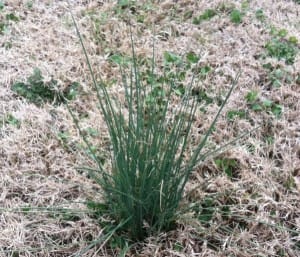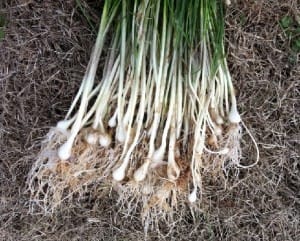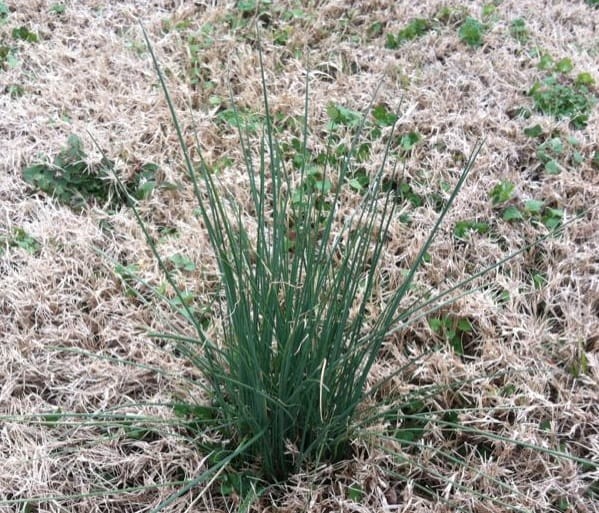
Wild Garlic Identification and Control In Home Lawns
Drs. Jialin Yu and Patrick McCullough, UGA
Wild garlic (Allium vineale L.) is a common weed in most turf areas throughout Georgia. It emerges from underground bulbs in late fall and grows through the winter and spring months. Wild garlic is a winter perennial plant that declines in early summer. This weed species is highly objectionable because it grows faster than cool-season turfgrasses after mowing and causes unsightly clumps in dormant warm-season turfgrasses during winter. Wild garlic has a similar appearance to wild onion (Allium canadense L.) but they are easily distinguishable by their leaves. Wild garlic has round hollow leaves and while wild onion has solid flat leaves.

Mowing is not effective for controlling wild garlic because bulbs or bulblets in the soil will continue to sprout and grow. In addition, the bulbs can remain viable in the soil for years before emergence. Mowing, however, can weaken the plants and help prevent the production of seeds.
Chemical control is similar for wild garlic and wild onion. Preemergence herbicides do not provide effective control. Multiple applications of postemergence herbicides over more than one season are typically required to control wild garlic. Wild garlic has slender and waxy leaves, which may reduce herbicide uptake. In Georgia, herbicides should be timed during winter or early spring before the formation of bulbs.
Synthetic auxin herbicides are typically the best herbicides to use in tall fescue lawns for wild garlic control. 2,4-D alone or in three-way mixtures with dicamba and mecoprop (Trimec, Triplet, Weed B Gone, etc.) effectively control wild garlic. These herbicides are safe in warm-season grasses during active growth but should not be applied during the spring green-up. Reduced rates are recommended when spraying to sensitive turfgrasses including centipedegrass and St. Augustinegrass. Using PowerZone or SpeedZone, which include carfentrazone and three-way synthetic auxin herbicides, may improve wild garlic control in cold winter. However, turfgrass tolerance to these products may vary and temporary turfgrass yellowing may occur on certain turfgrass varieties.
Postemergence control may also be achieved with ALS-inhibitor herbicides. Imazaquin (Image) controls wild garlic on warm-season turfgrasses but should not be used during spring greenup or on newly planted or sprigged lawns. Imazaquin will severely injure fescue and ryegrass.
Metsulfuron (Manor, Blade, others) effectively controls a wide number of broadleaf weeds and wild garlic. Metsulfuron can be applied to tolerant warm-season turfgrasses including bermudagrass, centipedegrass, St. Augustine, and zoysiagrass. However, applications may temporarily inhibit greenup of centipedegrass and other species during spring transition. Metsulfuron should not be used in lawns with desirable bahiagrass populations. Woody ornamentals should not be planted in treated areas within one year following the metsulfuron application.
Glyphosate may effectively control wild garlic in dormant bermudagrass. To avoid injuring desired turfgrasses that are not completely dormant, spot treatments should be used on sensitive turfgrasses.
Table 1. Postemergence herbicides for wild garlic control.
| Herbicide | Trade name | Rate (Product/Acre) | Tolerant Turfgrass |
| 2,4-D | 2,4-D Amine,
Weedar 64, and others |
See label | Kentucky bluegrass, bermudagrass, centipedegrass, tall fescue, zoysiagrass |
| 2,4-D + dicamba + MCPP | Trimec, trimec Southern,
Triplet Weed B Gone and others |
See label | Kentucky bluegrass, bermudagrass, centipedegrass, tall fescue, St. Augustinegrass, zoysiagrass |
| carfentrazone, MCPA, MCPP, dicamba | Powerzone | 2-6 pt | Tall fescue, Kentucky bluegrass, perennial ryegrass, red or fine fescue |
| carfentrazone, 2,4-D, MCPP, dicamba | Speedzone | 2-5 pt | Kentucky bluegrass, perennial ryegrass, tall fescue, colonial bentgrass, red or fine fescue, common bermudagrass, hybrid bermudagrass, zoysiagrass |
| imazaquin | Image | 8.6-11.4 oz | bermudagrass, centipedegrass, St. Augustinegrass, zoysiagrass |
| metsulfuron | Manor, Blade and others | 0.33-1.0 oz | Kentucky bluegrass, bermudagrass, centipedegrass, St. Augustinegrass, zoysiagrass |
| glyphosate | Roundup Pro, Touchdown and others | 0.75 pt | bermudagrass (dormant) |
